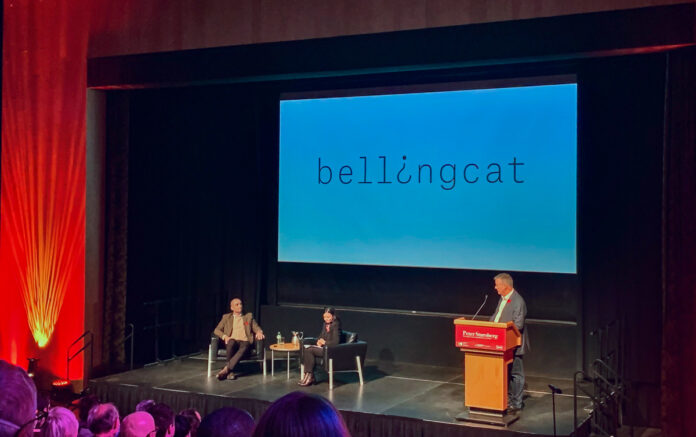
The 2022 Peter Stursberg Foreign Correspondents Lecture, hosted by Carleton University’s School of Journalism and Communication, was held at the Canadian War Museum on Nov. 4. This year’s lecture was a full house with 250 attendees in-person and more joining virtually.
Titled “Belling the Cat in Conflict Zones,” the lecture’s key speaker this year was Giancarlo Fiorella, a senior investigator at the Netherlands-based investigative group Bellingcat, a group specializing in open-source digital investigations. The event was moderated by Nahlah Ayed, former foreign correspondent and current host of CBC Radio’s Ideas.
The Stursberg lecture is held annually in honour of Canadian war correspondent Peter Stursberg. He was the first CBC journalist to cover Canadian troops in action using radio broadcasts during the Second World War. In 2014, he died at the age of 101 as the last living correspondent from the Second World War.
In 2014, Bellingcat helped determine who shot down Malaysian Airlines Flight 17 in Eastern Ukraine. It also contributed to exposing the identities of Russian spies involved in assassination missions.
At the lecture, Fiorella spoke the success of the organization’s methodology in verifying images online, which helped him last year while uncovering a massacre in Ethiopia’s Tigray region.
He credited Bellingcat’s use of geolocation, which he described as the use of “conceptual clues in the image to determine exactly where and when it was taken,” such as the colour of the soil and the positioning of the sun and its shadows, to reveal details of the Mahbere Dego Massacre.
Fiorella said determination, commitment to factual accuracy and a passion for justice are all required to be a digital investigator.
“I don’t consider myself a journalist,” he said. “I have all the admiration in the world for journalists who put themselves in all kinds of physical harm by going into conflict zones and speaking to people who have gone through horrible things.”
Despite the outlet’s non-traditional reporting style, Fiorella added that Bellingcat is winning journalism awards for its impactful work, such as the 2019 European Press Prize for investigative reporting and a News Emmy for Outstanding Investigative Report in a Newscast and Outstanding Research with CNN.
Fiorella said that one of the reasons behind Bellingcat’s international recognition is its production of digital, open-source information and its commitment to transparency in its published investigations.
Recently, Bellingcat has been working on documenting harm to civilians and civilian infrastructure in Ukraine through a civilian harm map, which was projected onto a screen behind Fiorella during the lecture.
“This map places in time incidents like the bombing of schools and hospitals, destruction of roads and libraries and the killing of civilians in the ongoing war in Ukraine,” Fiorella said. “Every dot on the map corresponds to an image showing the destruction and harm.”
The images on the map are sourced from the social media posts of Ukrainian citizens living in conflict zones and are verified by the Global Authentication Project, a community of open-source researchers who assist Bellingcat researchers.
During the lecture, an attendee asked Fiorella about the mental health impact of crisis data reporting and having to witness graphic images frame by frame. He said his colleagues and mental health resources are important coping mechanisms for him.
“I’ve seen the worst things people can do to each other online,” he responded. “It’s an occupational hazard and has changed the way I look at the world since starting at Bellingcat.”
Bellingcat has inspired news organizations like the BBC, the New York Times and the Washington Post to start their own open-source investigation units.
Professor Allan Thompson, head of the Carleton School of Journalism and Communication, noted in his closing remarks that the school would consider incorporating more digital journalism into the school’s journalism programming in the future.
Featured image by Nehaa Bimal.





